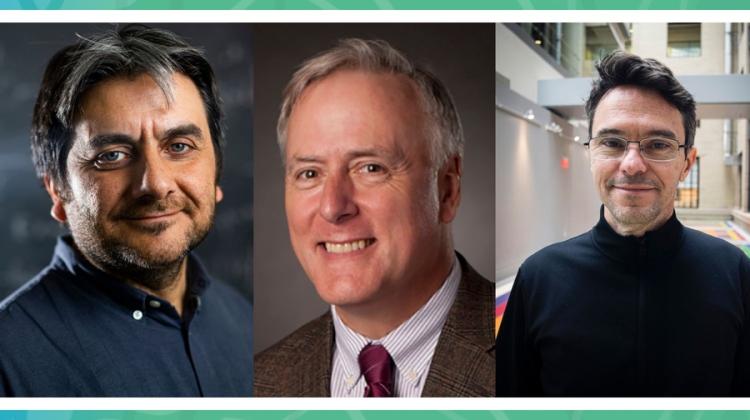J-WAFS 2023 Solutions Grants Bring Water-related Innovations to Market

(From left to right:) Cem Tasan, Andrew Whittle, and Fábio Duarte
The Abdul Latif Jameel Water and Food Systems Lab (J-WAFS) provides Solutions Grants to help MIT researchers launch startup companies or products to commercialize breakthrough technologies in water and food systems. The Solutions Grant Program began in 2015 and is supported by Community Jameel. In addition to one-year, renewable grants of up to $150,000, the program also matches grantees with industry mentors and facilitates introductions to potential investors. Since its inception, the J-WAFS Solutions Program has awarded over $3 million in funding to the MIT community. Numerous startups and products, including a portable desalination device and a company commercializing a novel food safety sensor, have spun out of this support.
The 2023 J-WAFS Solutions Grantees are Professor C. Cem Tasan of the Department of Materials Science and Engineering and Professor Andrew Whittle of the Department of Civil and Environmental Engineering. Tasan’s project involves reducing water use in steel manufacturing and Whittle’s project tackles harmful algal blooms in water. Project work commences this September.
“This year’s Solutions Grants are being award to professors Tasan and Whittle to help commercialize technologies they have been developing at MIT,” says J-WAFS executive director Renee J. Robins. “With J-WAFS’ support, we hope to see the teams move their technologies from the lab to the market, so they can have a beneficial impact on water use and water quality challenges,” Robins adds.
Reducing water consumption by solid-state steelmaking
Water is a major requirement for steel production. The steel industry ranks fourth in industrial freshwater consumption worldwide, since large amounts of water are needed mainly for cooling purposes in the process. Unfortunately, a strong correlation has also been shown to exist between freshwater use in steelmaking and water contamination. As the global demand for steel increases and freshwater availability decreases due to climate change, improved methods for more sustainable steel production are needed.
A strategy to reduce the water footprint of steelmaking is to explore steel recycling processes that avoid liquid metal processing. With this motivation, Cem Tasan, the Thomas B. King Associate Professor of Metallurgy in the Department of Materials Science and Engineering, and postdoc Onur Guvenc PhD created a new process called scrap metal consolidation (SMC). SMC is based on a well-established metal forming process known as roll bonding. Conventionally, roll bonding requires intensive prior surface treatment of the raw material, specific atmospheric conditions, and high deformation levels. Tasan and Guvenc’s research revealed that SMC can overcome these restrictions by enabling the solid-state bonding of scrap into a sheet metal form, even when the surface quality, atmospheric conditions, and deformation levels are suboptimal. Through lab-scale proof-of-principle investigations, they have already identified SMC process conditions and validated the mechanical formability of resulting steel sheets, focusing on mild steel, the most common sheet metal scrap.
The J-WAFS Solutions Grant will help the team to build customer product prototypes, design the processing unit, and develop a scale-up strategy and business model. By simultaneously decreasing water usage, energy demand, contamination risk, and carbon dioxide burden, SMC has the potential to decrease the energy need for steel recycling by up to 86 percent, as well as reduce the linked carbon dioxide emissions and safeguard the freshwater resources that would otherwise be directed to industrial consumption.
Detecting harmful algal blooms in water before it’s too late
Harmful algal blooms (HABs) are a growing problem in both freshwater and saltwater environments worldwide, causing an estimated $13 billion in annual damage to drinking water, water for recreational use, commercial fishing areas, and desalination activities. HABs pose a threat to both human health and aquaculture, thereby threatening the food supply. Toxins in HABs are produced by some cyanobacteria, or blue-green algae, whose communities change in composition in response to eutrophication from agricultural runoff, sewer overflows, or other events. Mitigation of risks from HABs are most effective when there is advance warning of these changes in algal communities.
Most in situ measurements of algae are based on fluorescence spectroscopy that is conducted with LED-induced fluorescence (LEDIF) devices, or probes that induce fluorescence of specific algal pigments using LED light sources. While LEDIFs provide reasonable estimates of concentrations of individual pigments, they lack resolution to discriminate algal classes within complex mixtures found in natural water bodies. In prior research, Andrew Whittle, the Edmund K. Turner Professor of Civil and Environmental Engineering, worked with colleagues to design REMORA, a low-cost, field-deployable prototype spectrofluorometer for measuring induced fluorescence. This research was part of a collaboration between MIT and the AMS Institute. Whittle and the team successfully trained a machine learning model to discriminate and quantify cell concentrations for mixtures of different algal groups in water samples through an extensive laboratory calibration program using various algae cultures. The group demonstrated these capabilities in a series of field measurements at locations in Boston and Amsterdam.
Whittle will work with Fábio Duarte of the Department of Urban Studies and Planning, the Senseable City Lab, and MIT’s Center for Real Estate to refine the design of REMORA. They will develop software for autonomous operation of the sensor that can be deployed remotely on mobile vessels or platforms to enable high-resolution spatiotemporal monitoring for harmful algae. Sensor commercialization will hopefully be able to exploit the unique capabilities of REMORA for long-term monitoring applications by water utilities, environmental regulatory agencies, and water-intensive industries.


